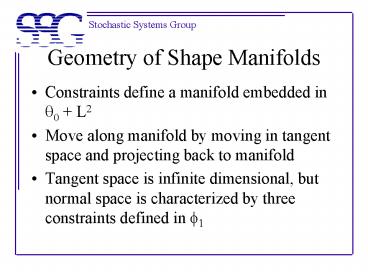Geometry of Shape Manifolds - PowerPoint PPT Presentation
Title:
Geometry of Shape Manifolds
Description:
Move along manifold by moving in tangent space and projecting back to manifold ... Approximate f with its first m 1 cosine components and its first m sine components: ... – PowerPoint PPT presentation
Number of Views:92
Avg rating:3.0/5.0
Title: Geometry of Shape Manifolds
1
Geometry of Shape Manifolds
- Constraints define a manifold embedded in q0 L2
- Move along manifold by moving in tangent space
and projecting back to manifold - Tangent space is infinite dimensional, but normal
space is characterized by three constraints
defined in f1
2
Tangents and Normals
- The derivative of f1 in the direction of f at ?
is - Implies df1 is surjective
- If f is orthogonal to 1, sin q, cos q, then
df10 in the direction of f and hence f is in the
tangent space
3
Projections
- Want to find the closest element in C1 to an
arbitrary q ? q0 L2 - Basic idea move orthogonal to level sets so
projections under f form a straight line in R3 - For a point b ? R3, we define the level set as
- Let b1(p,0,0). Then its level set is the
preshape space C1
4
Approximate Projections
- If points are close to C1, then one can use a
faster method - Let dq be the normal vector at q for which
f(qdq)b1. Can do first order approximation to
compute this - Approximate Jacobian as
5
Iterative algorithm
- Define the residual (error) vector as
- Then
- where
- Iteratively update q dq? q until the error goes
to zero - Call this projection operator P
6
Example Projections
Fig. 1 Projections of arbitrary curves into C1
7
Geodesics
- Definition For a manifold embedded in Euclidean
space, a geodesic is a constant speed curve whose
acceleration vector is always perpendicular to
the manifold - Define the metric between two shapes as the
distance along the manifold between the shapes
with respect to the L2 inner product - Nice features
- Defined for all closed curves
- Interpolants are closed curves
- Finds geodesics in a local sense, not necessarily
global
8
Paths from initial conditions
- Assume we have a q in C1 and an f in the tangent
space - Approximate geodesic along manifold by moving to
qfDt and projecting that back onto the manifold
(Dt is step size) - So q(tDt) P(q(t)f(t)Dt)
9
Transporting the tangent vector
- Now f(t) is not in the tangent space of q(tDt)
- Two conditions for a geodesic
- The acceleration vector must be perpendicular to
the manifold simply project f into the next
tangent space - The curve must move at constant speed
renormalize so f(t1)f(t) - hk is the orthonormal basis of the normal space
10
Geodesics on shape spaces
- S1 is a quotient space of C1 under actions of S1
by isometries, so finding geodesics in S1
equivalent to finding geodesics in C1 which are
orthogonal to S1 orbits - S1 acting by isometries implies that if a
geodesic in preshape space is orthogonal to one
S1 orbit, its orthogonal to all S1 orbits which
it meets - So now normal space has one additional component
spanned by - The algorithm is the same as detailed earlier
except with an expanded normal space
11
Geodesics between shapes
- We know how to generate geodesic paths given q
and f - Now we want to construct a geodesic path from q1
to q2 - So we need to find all f that lead from q1 to an
S1 orbit of q2 in unit time, and then choose the
one that leads to the shortest path - Let Y define the geodesic flow, with ?(q1,0,f)q1
as the initial condition - We then want Y(q1,1,f)q2
12
Finding the geodesic
- Define an error functional which measures how
close we are to the target at t1 - Choose the geodesic as the flow Y which has the
smallest initial velocity f - i.e., min f s.t. Hf0
- Hard because infinite dimensional search
13
Fourier decomposition
- f ? L2, so it has a Fourier decomposition
- Approximate f with its first m1 cosine
components and its first m sine components - Let a be the vector containing all of the Fourier
coefficients - Now optimization problem is min a s.t. Ha0
14
Geodesic paths
Fig. 2 Geodesic paths between two shapes































